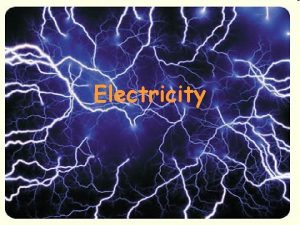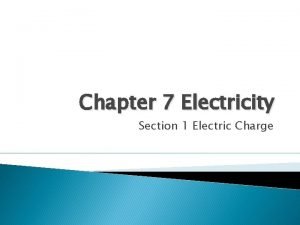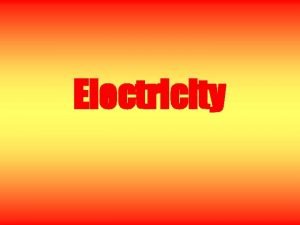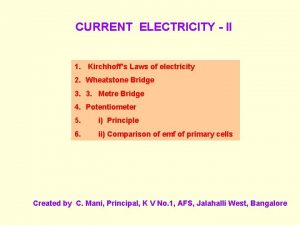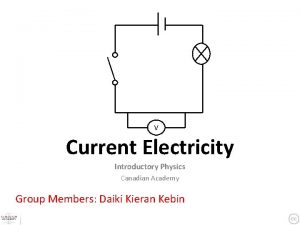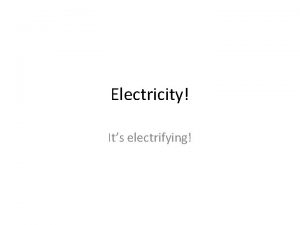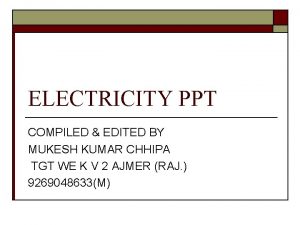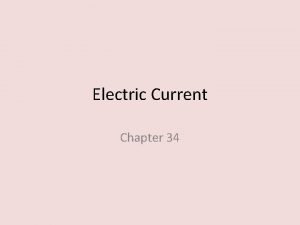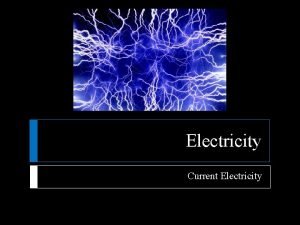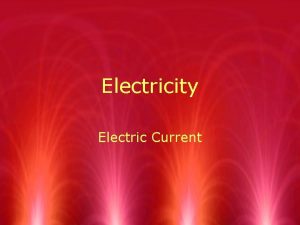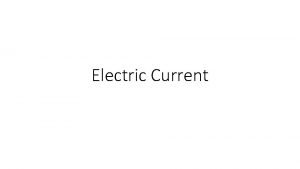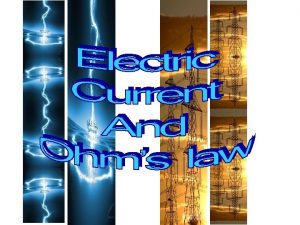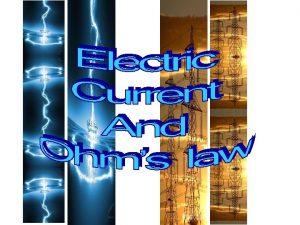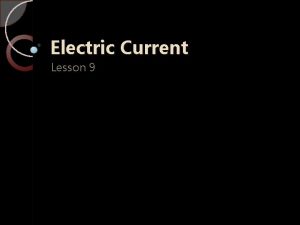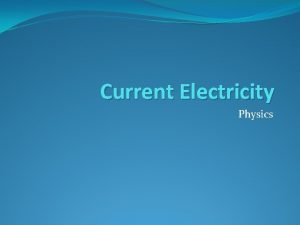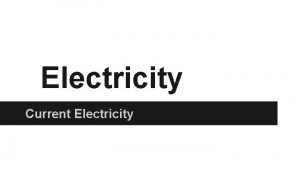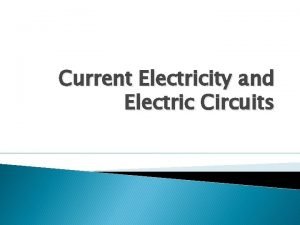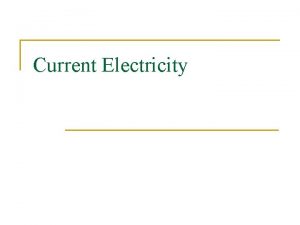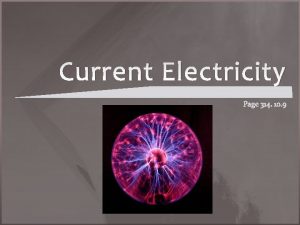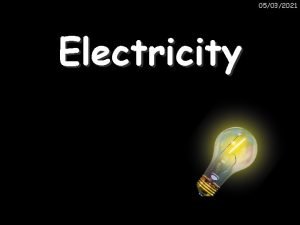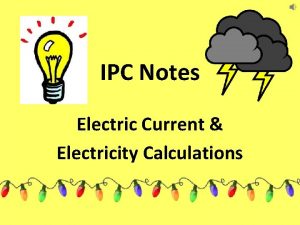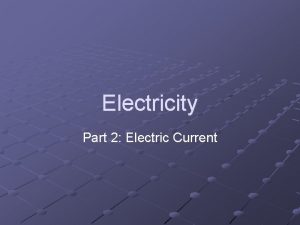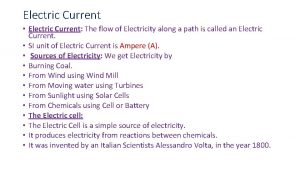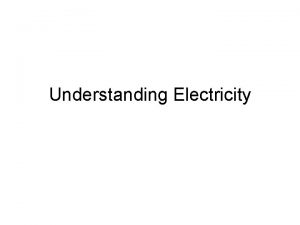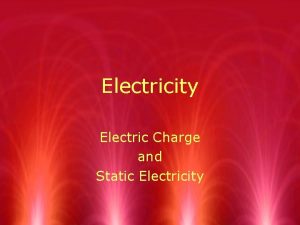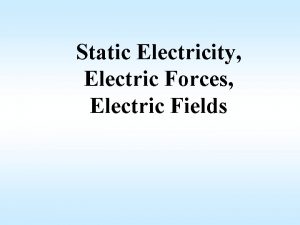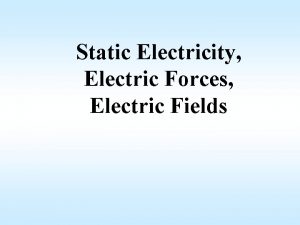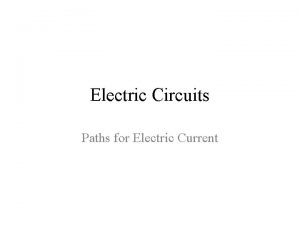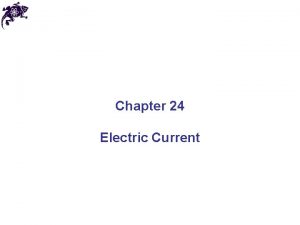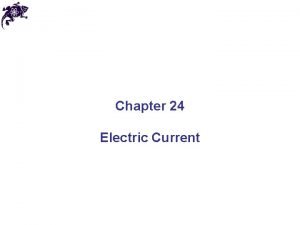CURRENT ELECTRICITY CURRENT q Electric Current I The

























- Slides: 25

CURRENT ELECTRICITY

CURRENT q Electric Current (I)- The amount of charge that passes through an area in a given amount of time, usually electrons. Units for I are amperes (A or amps) or C/s – Why? § Current that flows in one direction is direct current (DC) § Current that alternates direction is alternating current (AC) §

POTENTIAL DIFFERENCE Another term for potential difference (V) is voltage (V) Units-volts (V) The voltage measures the electric potential difference between two points. Electric current will flow from high to low potential -the greater the difference, the greater the electron flow. Circuits: Electron Flow vs Conventional Flow


POTENTIAL DIFFERENCE SOURCES EXAMPLES Voltaic Cell- cell that converts chemical energy into electric energy. Ø Battery- several cells together to produce electric energy from chemical energy Photovoltaic- solar cell, converts light energy to electric energy. Generators, power plants

RESISTANCE – AN OPPOSITION TO THE FLOW OF CHARGE: UNITS FOR RESISTANCE = OHM’S RESISTORS - DEVICES DESIGNED TO HAVE A SPECIFIC RESISTANCE. EX. POTENTIOMETER

OHM’S LAW When charges pass through a resistance (resistor), some electrical energy is changed to other forms (usually heat). This is produced by a potential difference across the resistance (resistor) Ohm’s Law Equation: Conductors I = V/R or V = IR have little resistance to electron flow Insulators have great resistance to electron flow.

OHM’S LAW EXAMPLE While cooking dinner, Dinah’s oven uses 220 V line and draws 8 A of current when heated to its maximum temperature. What is the resistance of the oven when it is fully heated?

ELECTRIC POWER Electric Power- the product of voltage x current. Equation: P=Vx. I Power = Voltage x Current Units: Watts The unit for current is the ampere. 1 ampere = 1 Coulomb/ second Found by a French scientist Andre Ampere Manipulations & Substitutions What if you are not given Voltage? What if you are not given Current?

OHM’S LAW An alarm clock with a resistance of 60 W is plugged into a 110 V outlet. What is its power rating?


ELECTRIC ENERGY & COST High voltage transmission lines carry electrical energy over long distances with minimal loss of energy. Ex. Power Plants The kilowatt-hour is a unit of energy. Energy = Power x time (units: kilowatt-hour) Calculating Cost: Cost = Energy Used x $Price/k. Wh

A toaster with resistance 20 W draws 6. 0 A when connected to a potential difference. a) What is the power rating of this toaster? b) How much does it cost to run the toaster for 2 hours a day at $0. 10/k? What if it operates 4 days a week for 4 weeks?

POWER & COST The Garcia’s like to keep their 40 W front porch light on at night to welcome visitors. If the light is on from 6 PM to 7 AM, and the Garcia’s pay 8 cents per k. Wh, how much does it cost to run the light for this amount of time each week?

ELECTRIC CIRCUIT Electric Circuit- charges moving around a closed loop from a pump(battery) back to the pump. There are two basic types of circuits: series and parallel. There is only one path or branch for electron flow in a series circuit. There are multiple branches or paths in a parallel circuit.


SERIES CIRCUITS EXAMPLE A 4 W and a 6 W resistor are connected in series with a 12 V battery. Draw a schematic and find: • Total resistance • Total current • Voltage and current through each resistor

INTERNAL RESISTANCE EMF = a device that transforms one type of energy into electrical energy (ie battery) A battery itself has some resistance, which is called internal resistance, designated as r and can be represented is series with the terminal itself (thus can never be separated). Examples: Lights dimming in your car when you turn it on. Terminal Voltage – a measure of the actual emf (voltage) when a current flows from a battery (not the rated emf). Example: If a 12 V battery has an internal resistance of. 1 Ω and 10 A flows from the battery. The terminal voltage is 12 V – (10 A)(. 1Ω) which is equivalent to 11 V’s.

INTERNAL RESISTANCE EXAMPLE A 2Ω resistor and a 4Ω resistor are arranged in series to a 20 V emf which has an internal resistance of 1Ω. Determine the current running through the circuit and the voltage drop across each resistor to include the terminal voltage:

SHARING OF CHARGE Capacitors – A device that can store electric charge (Q) on two parallel conducting plates (Pot. Difference or V). A measure of the amount of charge (Q) stored on the conductors for a given potential difference. Equation: Capacitance (C): C = Q / V Units: Farad (1 Coulomb per Volt) For a given capacitor (C), the amount of charge (Q) acquired by each plate is found to be proportional to the potential difference (V): Q = CV Examples: Pacemakers, Computers, Camera Flashes, Human Nervous System

CAPACITANCE EXAMPLE The first capacitor was invented by Pieter van Musschenbroek in 1745 when he stored a charge in a device called a Leyden jar. If 5 x 10 -4 C of charge were stored in the jar over a potential difference of 10, 000 V, what was the capacitance of the Leyden jar? Consequently, when he touched the jar, he received a large jolt!!!

RC CIRCUITS Capacitors and resistors can work together in a circuit. Essentially it is a way to charge a capacitor while continuously supplying energy to the resistor (Remember V = Q/C). Once the capacitor is fully charged or matches the applicable emf, no further current flows. Examples: Pacemaker, Computer Screens …

CAPACITORS IN SERIES & PARALLEL Parallel: If a battery of voltage V (constant) is connected in parallel to each of the capacitors, then each capacitor will acquire a charge equivalent to the same voltage down each parallel branch: Q 1 = C 1 V, Q 2 = C 2 V, Q 3 = C 3 V … Thus Q = Q 1 + Q 2 + Q 3 and…CV = C 1 V + C 2 V + C 3 V… C = C 1 + C 2 + C 3 (Parallel Capacitance) Series: Now the voltage V (not constatnt) across the three capacitors in series must equal the sum of the voltages across each capacitor: V = V 1 + V 2 + V 3…Thus Q/C = Q/C 1 + Q/C 2 + Q/C 3… 1/C = 1/C 1 + 1/C 2 + 1/C 3 (Series Capacitance)

RC EXAMPLE (IN PARALLEL) From the Internal Resistance example, determine the charge Q on a 3μF capacitor that is in parallel with the 4Ω resistor.

ENERGY TRANSFERS IN CIRCUITS Equation: Power = Current 2 x Resistance When a capacitor is charged or discharged through a resistor, the current is high initially and falls to 0 The energy transferred is the product of power and time. Equation: Energy = I 2 Rt
 Electricity and magnetism vocabulary
Electricity and magnetism vocabulary Static electricity and current electricity
Static electricity and current electricity Static electricity and current electricity
Static electricity and current electricity Chapter 6 electricity section 1 electric charge answers
Chapter 6 electricity section 1 electric charge answers Electricity section 1 electric charge
Electricity section 1 electric charge Electricity section 1 electric charge
Electricity section 1 electric charge Venn diagram of series circuit and parallel circuit
Venn diagram of series circuit and parallel circuit What is electrical
What is electrical Current electricity
Current electricity Electrons flowing
Electrons flowing What is current electricity in physics
What is current electricity in physics Electricity def
Electricity def Current electricity ppt
Current electricity ppt Bill nye static electricity worksheet
Bill nye static electricity worksheet Electric force
Electric force A suitable electric pump in an electric circuit is a
A suitable electric pump in an electric circuit is a Dc o/d per item charge
Dc o/d per item charge Electric potential class 12
Electric potential class 12 Electric field and voltage
Electric field and voltage Chapter 21 electric charge and electric field
Chapter 21 electric charge and electric field Electric charges and electric forces lesson outline
Electric charges and electric forces lesson outline Potential energy of capacitor
Potential energy of capacitor Chapter 21 electric charge and electric field
Chapter 21 electric charge and electric field Electric potential and electric field
Electric potential and electric field Chargeflow
Chargeflow Electric current
Electric current




